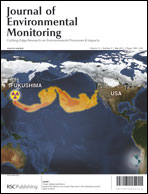Journal of Environmental Monitoring 14(5)
Overview of new articles on POPs in a new issue of the Journal of Environmental Monitoring.

A. D. McIntosh, R. J. Fryer, L. Webster and A. B. Cundy
p. 1335-1344
- An aluminium smelter discharged polycyclic aromatic hydrocarbons (PAHs) into Loch Leven on the west of Scotland from 1907 until it closed in 2000, resulting in elevated PAH concentrations in the sediment. A temporal monitoring programme to investigate any recovery in sediment concentrations began in 2004, with sampling each year until 2008 and again in 2010. Cores were also collected to investigate temporal trends over a longer time scale and to estimate the sedimentation rate in the loch.
Serpil Yenisoy-Karakaş, Muhammed Öz and Eftade O. Gaga
p. 1365-1374
- Daily gas and particle phase samples were collected during winter and summer seasons in Bolu, which is located in the high altitude Western Black Sea Region of Turkey. Samples were analyzed to determine the concentrations of polychlorinated biphenyls (PCBs) and organochlorine pesticides (OCPs). Concentrations of endosulfan sulfate and methoxychlor were found to be highest in the summer and winter periods, respectively.
Lazhar Mhadhbi, Diego Rial, Sara Pérez and Ricardo Beiras
p. 1375-1382
- Perfluorooctanoic acid (PFOA) and perfluorooctane sulfonic acid (PFOS) are anthropogenic substances classified as persistent bioaccumulative compounds and are found in various environmental compartments throughout the world, from industrialized regions to remote zones far from areas of production. In this study, we assessed the effects of PFOA and PFOS on early life stages of marine test species belonging to three different trophic levels: one microalga (Isochrysis galbana), a primary consumer (Paracentrotus lividus) and two secondary consumers (Siriella armata and Psetta maxima).
S. Doni, C. Macci, E. Peruzzi, M. Arenella, B. Ceccanti and G. Masciandaro
p. 1383-1390
- In the past several years, industrial and agricultural activities have led to serious environmental pollution, resulting in a large number of contaminated sites. As a result, much recent research activity has focused on the application of bioremediation technologies as an environmentally friendly and economically feasible means for decontamination of polluted soil. In this study horse manure and Populus nigra (var. italica) (HM + P treatment) have been used, at real scale level, as an approach for bioremediation of a soil historically contaminated by metals (Pb, Cr, Cd, Zn, Cu and Ni) and organic contaminants, such as polychlorobiphenyls and petroleum hydrocarbon.
5.5.2012




